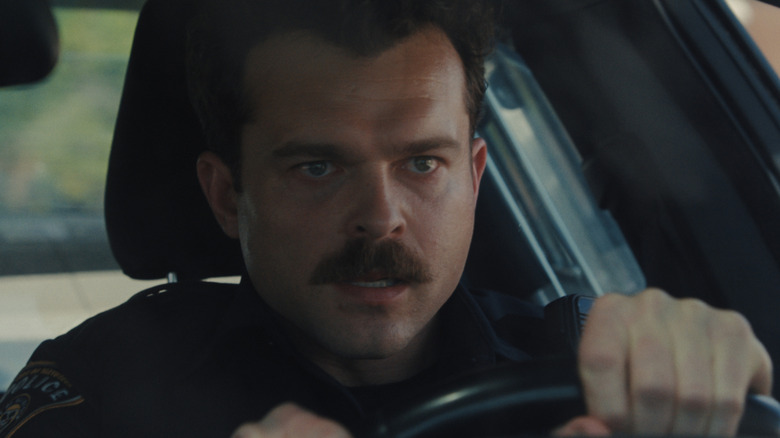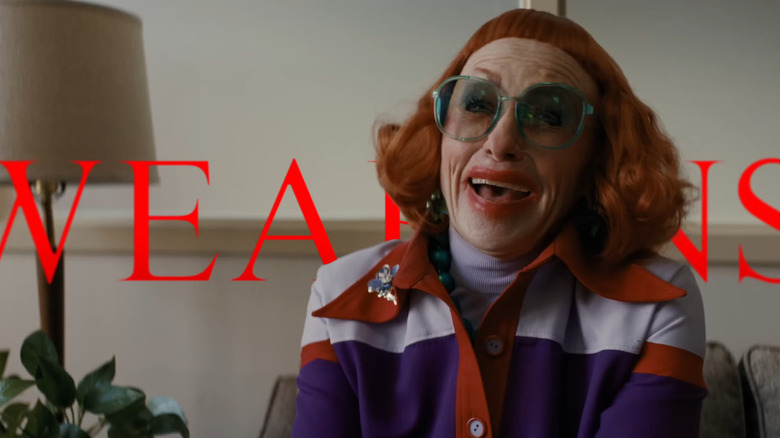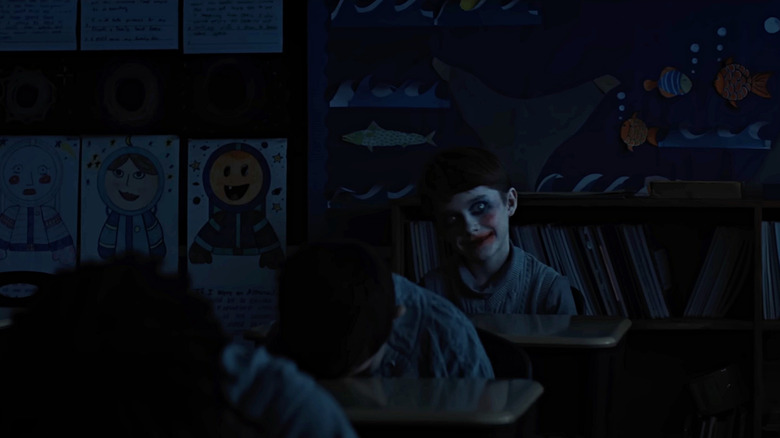Weapons' Mysterious Villain Explained
This article contains spoilers for "Weapons."
"Weapons," the latest horror feature from writer/director Zach Cregger, is a masterclass in manipulation — in more ways than one. Cregger's prior film (his first as a solo filmmaker), "Barbarian," was a movie that was very clever in its misdirection, leading audiences to believe one thing was happening when it wasn't, and hiding what was actually happening from people until the proverbial trap was ready to be sprung. Given the general rapturous response to that movie, Cregger must have been aware that his follow-up would be under heavy scrutiny for any big twists and turns from the start, something which "Barbarian" didn't have to deal with. As such, Cregger has built "Weapons" around the very idea of an unsolved mystery. In other words, both the film's characters and the viewing audience are asking the same central question: what happened to 17 particular children who left their homes in the early morning/one night and vanished?
Owing a debt to other mystery box films and shows like "Knock at the Cabin" and "The Leftovers," "Weapons" gets its narrative energy from following an ensemble of characters as they all attempt to solve and/or deal with this mystery in their own way. General audiences have been trained to search for clues and put them together thanks to decades of twisty stories, and there's an impulse some have to leap to the wildest theory imaginable in an effort to outsmart the filmmaker (if the response to HBO's "Westworld" is any indication). Cregger subverts this impulse by hiding the answer in plain sight toward the beginning of the film. In the movie's first segment centered around Justine (Julia Garner), the schoolteacher whose class is the one thing all the missing children had in common, the woman's car is vandalized, the word "WITCH" painted on the side.
Indeed, there is a witch to blame for the children's disappearance, but it isn't poor Justine. Instead, its Gladys Lilly (Amy Madigan), the aunt of Alex (Cary Christopher), who is the one child who didn't go missing from Justine's class. This relatively straightforward reveal may further frustrate some viewers given the large amount of ambiguity surrounding Gladys' methods and motivations. Here, then, is all we know about Aunt Gladys, followed by an attempt to try and lay out what exactly she might've been up to.
Who is Aunt Gladys, literally and figuratively?
In Dutch filmmaker George Sluizer's 1988 thriller "The Vanishing," the protagonist is tortured and eventually undone by the prospect of never knowing what happened to his abducted girlfriend. In the same way that one could view the ending of that movie as a twisted punchline, Cregger uses the character of Gladys in "Weapons" as a similarly sick joke, one that's played more on the audience than the other characters. With the exception of seeing her withered and frail in some of her private moments, Gladys is often portrayed in the movie as a gaudy, unexpectedly polite, and chipper figure. Her over-the-top makeup and bright red hair almost make her appear to be a sort of clown. This of course ties her to the long history of killer clowns in real life and in fiction, but it feels like "Weapons" isn't trying to make a John Wayne Gacy or Pennywise comparison as much as it's interested in the tonal juxtaposition of Gladys' character.
This range of tonal colors to Gladys is something actress Amy Madigan pulls of with aplomb. As it turns out, her prowess with the role is one of the main reasons why Cregger was eager to give her the part. As the filmmaker explained in an exclusive interview with /Film's Chris Evangelista:
"...I've always been a huge fan of hers, and I just know that she can do anything. You watch her in 'Field of Dreams' and she's this firecracker and totally bouncy and just really funny. And then you watch her and 'Gone Baby Gone,' and she's just heavy. And then you watch her in "Carnivale," and she's intimidating. So I was just like, 'She can excel at everything I need this character to excel in.'"
In conjunction with Cregger wanting Madigan to play a variety of tones and emotions, the character of Gladys has many layers of subtext and subversion to her. Instead of being a demonic mastermind playing an insidious, intricate long game (as with the witches seen in Ari Aster's "Hereditary," for instance), Gladys is simply an ill woman using her skills in order to try to get well and live longer. She's a manipulator both in her demeanor (being overly kind to strangers to get them to let their guard down) and in her witchcraft (controlling the minds of others in order to use them for their lifeforce or as weapons). She gets her real power from hiding in plain sight, just like the "WITCH" clue on Justine's car.
Why did Gladys take the schoolchildren, and what was she doing with them?
One of the ingenious aspects of "Weapons" is how it leans into its allusions to true crime and supernatural mystery, two subgenres that are famous for getting into the weeds of a mystery and coming up with outrageous, intricate theories. Where Justine, Archer (Josh Brolin), and the audience may have their minds racing with possibilities regarding the missing Maybrook kids, along comes Gladys as a rejoinder to all of that. Gladys, again, is not a mastermind; she's simply an opportunist. The main reason she used her witchcraft to abduct 17 kids from one classroom is that she could ask her nephew in that class, Alex, to surreptitiously obtain the objects she needed from them without suspicion. She puts Alex's parents under her spell because they're her family and the two nearest people she can start with. She avoids putting Alex in her thrall to help maintain a public normalcy for as long as possible. She only attacks Justine, Archer, and others when they get too close to discovering her secret. She's very practical!
Taking that practicality into account, the reason for Gladys' abduction of the children seems to be solely for whatever supernatural process allows her to siphon a healing life force from their bodies (or souls, perhaps). Cregger even adds a further subversion on top of Gladys' plot, which is that this spell apparently doesn't work as well as she'd hoped. Similar to someone thinking that taking eight Tylenol instead of the recommended two will quell their headache, Gladys is simply attempting to up the dosage on her healing spell with the children. One of the ironies in the film is that, if Gladys knew ahead of time it wouldn't be that effective, perhaps she wouldn't have gone to all that trouble of the abduction, the cover-up, and so on.
This feeds into one of the central themes of the movie, which is that a large number of tragic, horrific events sometimes have mundane explanations, which is sometimes worse than no explanation at all. The theme can be seen throughout the film, and is perhaps best exemplified by the non-significance of the time of 2:17am, when the children leave their homes. Rather than this particular time being somehow important, it turns out to simply be when Gladys finished concocting her spell and executed it; it could've been a minute earlier, a minute later, or a half-hour later. In the way that Gladys weaponizes the people around her, Cregger weaponizes the audiences minds and expectations against them. As "Weapons" proves, it's super effective.


